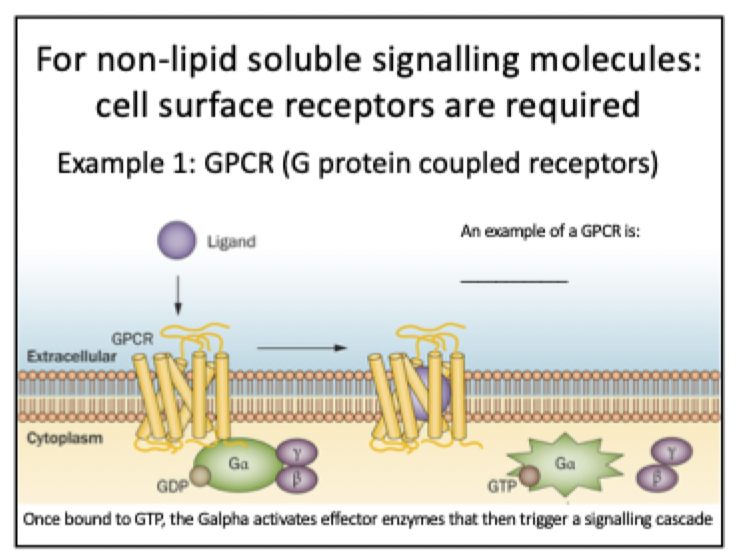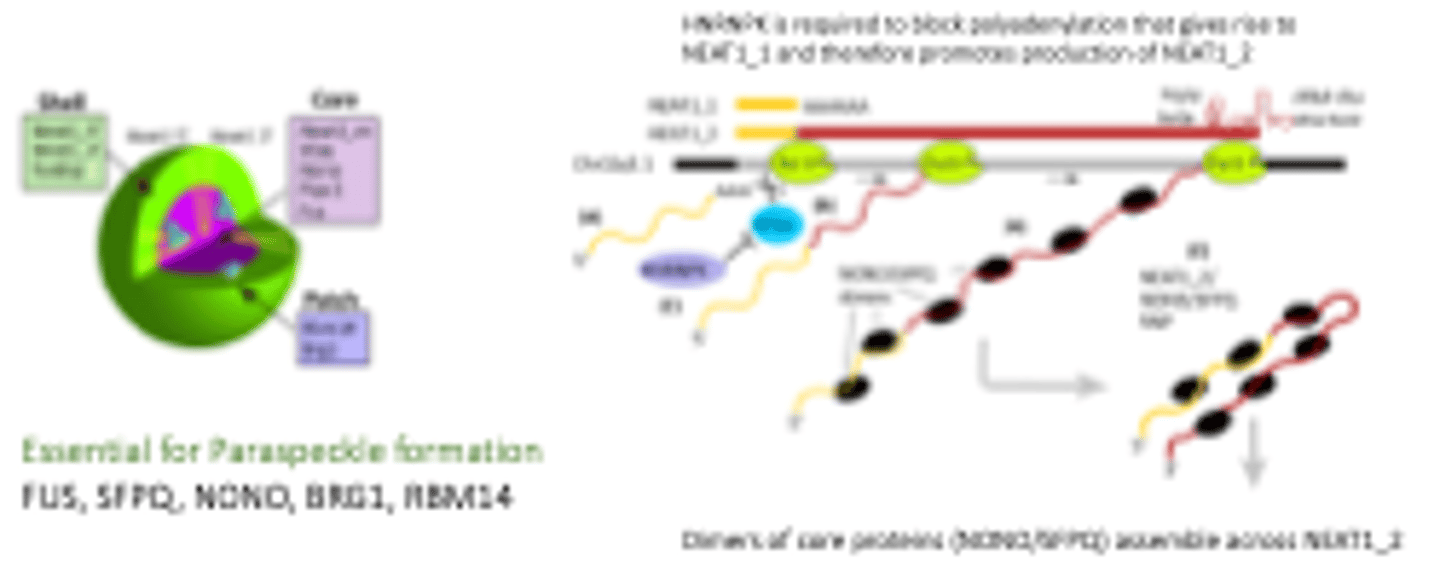Week 3 - Nucleus and gene expression
1/42
Earn XP
Description and Tags
ANHB3323
Name | Mastery | Learn | Test | Matching | Spaced |
|---|
No study sessions yet.
43 Terms
How do Cells respond to their environment? (4 things)
1. Signalling
2. Receptors
3. Intermediaries (cascade of events triggered by signalling)
4. Nuclear translocation and import
[all 4 lead to gene regulation]
Chemical Messangers (4 categories/examples)
Have effect on local or far away tissue
Examples:
growth factors
hormones
neurotransmitters
extracellular matrix components
Must interact with plasma membrane
Receptors are either...
Membrane bound proteins
or
Intracellular receptors, lipid soluble molecules bind to them
Estrogen signalling (5 basic steps)
1. estrogen enters cell
2. binds to receptor in cytoplasm
3. receptor dimerises
4. receptor translocates to nucleus
5. activates gene expression
Dimerised receptor
two molecules come together
changes shape
once shape is changed, can pass through nuclear pore and affect gene expression
Examples of Surface Receptors (membrane bound receptors)
1. GPCR
e.g. Frizzled
2. Ion Channels
3. Receptor Tyrosine kinases
[all for non lipid soluble molecules]
G protein coupled receptor (GPCR)
Ligand binds extracellularly
activates g protein
g protein = heterotrimeric protein complex in the plasma membrane.
The G protein undergoes GDP-GTP exchange
Alpha subunit dissociates from beta-gamma dimer
Both subunits react with downstream effectors
e.g. Frizzled receptor in Wnt/β-catenin pathway

ion channel
Messenger binds to receptor
Receptor changes shape
Ions pass through via conc. gradient
Tyrasine Kinase
Kinase is an enzyme that adds phosphate groups onto molecules
Ligand binds to receptor
Receptor dimerises
Tyrasine kinase tails are phosphorylated
triggers secretion of secondary messengers
example: epidermal growth factor/EGFR)
Non-lipid soluble signalling
cell surface receptors are required
ligand binds to receptor
initiates secondary receptors
Signal Transduction cascades
Transmission of signal to the nucleus:
via Secondary messengers
there can be multiple secondary messengers
What does a signal transduction result in?
Post-translational modifications (usually phosphorylation)
Protein-Protein interactions
e.g. dimerisation
Secondary messenger example
PIP3
(generated by PI3K)
PI3K
generates secondary messenger PIP3
resulting in:
activation of AKT = cell growth/proliferation
mechanism used by cells of the immune system
JAK-STAT signalling (7 steps)
example of secondary messengers
1. binding of ligand = dimerisation
2. receptor phosphorylation
3. STAT binds
4. JAK phosphorylates STAT
5. STAT dimerises
6. translocation to nucleus (STAT)
7. transcriptioin activated
How does Nuclear Translocation occur?
Phosphorylation and dimerisation
e.g. JAK-STAT
or
Increased levels of messenger molecules
Via concentration gradient
Apoptosis vs Necrosis
Apoptosis = programmed cell death
Necrosis = not programmed cell death (in response to injury)
what does Apoptosis activate?
proteases + nucleases
Necrosis (what happens)
Progressive injury to normal cell resulting in:
inflammation
breakdown of membrane, organelles and nucleus
leakage of cellular contents
and cell death
Apoptosis (what generally happens)
condensation of chromatin + membrane begins to bleed
=
cellular fragmentation + apoptotic bodies release
(then phagocytes remove apoptotic bodies and fragments)
Apoptosis signalling
Mitochondrial release of Cytochrome C = capsase activation
Capsase activation = break down cell
Cause of Apoptosis signalling (3 things)
Either:
1. FAS ligand
2. ER stress
3. DNA damage
P53 location (in cell)
Nucleus
at low levels (because it is degraded by MDM2 )
P53 functions
Tumour suppressant
prevents cell division
prevents cell growth
What happens inside the Nucleus (4 things)
1. transcription (DNA to mRNA)
2. processing/export of mRNA
3. DNA replication
4. DNA integrity/repair
Birth of Daughter Nuclei
Each cell division:
nuclear envelope breaks down and is reformed
Nuclear factors have to be re-imported via nuclear pores
Nuclear organisation has to be re-created
Each cell is established by the formation of a new nucleus
Nuclear envelope
Double Membrane:
1. Outer = continuous with Rough ER
2. Inner = associates with nuclear lamina
has pores for import/export, molecules sit in the space between the two sheets of membrane
Nuclear import/export
All molecules pass through nuclear pores
Passive diffusion:
- for molecules under 20-30kDa
Large proteins:
- have export/import signals
- need cargo molecules which act as carriers
Nuclear lamina
Composed of lamina proteins:
gives structural stability to nucleus

Mutations in Lamin Genes
Cause/lead to:
progeria (premature ageing)
other muscle diseases
Lamin Mutations
1. Nucleus cannot withstand mechanical stress
2. Alters nuclear organisation = gene expression changes
What is found inside the Nucleus?
Chromatin = DNA + packaging proteins
What is Chromatin connected to?
the Nuclear Lamina
Chromosome Territories
defined location of each chromosome:
- some at the periphery
- some in the centre
What influences Chromosome Territories?
Cell type + shape
Size of chromosome (larger chromosome are usually at the periphery)
Fluorescent in Situ Hybridisation (FISH)
Used to localise DNA sequences
How:
short fragments ('probe') of DNA complement sequence of interest
probe is labelled with fluorescent dye
target DNA is deanatured, allowing probe to anneal
It is possible to FISH on multiple chromosomes are the same time
Nucleolus (general info)
Forms around ribosomal DNA repeat
Densest part of cell
Nucleolus function
Site of:
ribosome production
subnuclear sequestration of regulatory molecules
Paraspeckles (general info)
Stress-induced subnuclear bodies
Built around long noncoding RNA (NEAT1)
Paraspeckles function
Regulate gene expression by:
- Sequestration of paraspeckle proteins
Paraspeckle substructure
Has distinct zones:
- Core
- Shell
- Patch

Molecular movement
Despite crowding, molecules move rapidly throughout the nucleus
inactive genes in the middle
Actively transcribed genes are found at the edges or outside the territory
genes cluster together to be transcribed
How to determine how fast molecules move in living cells
Photodynamics, via fluorescent protein fusion:
- bleach protein
- image recovery of fluorescence (how long it takes to recover)